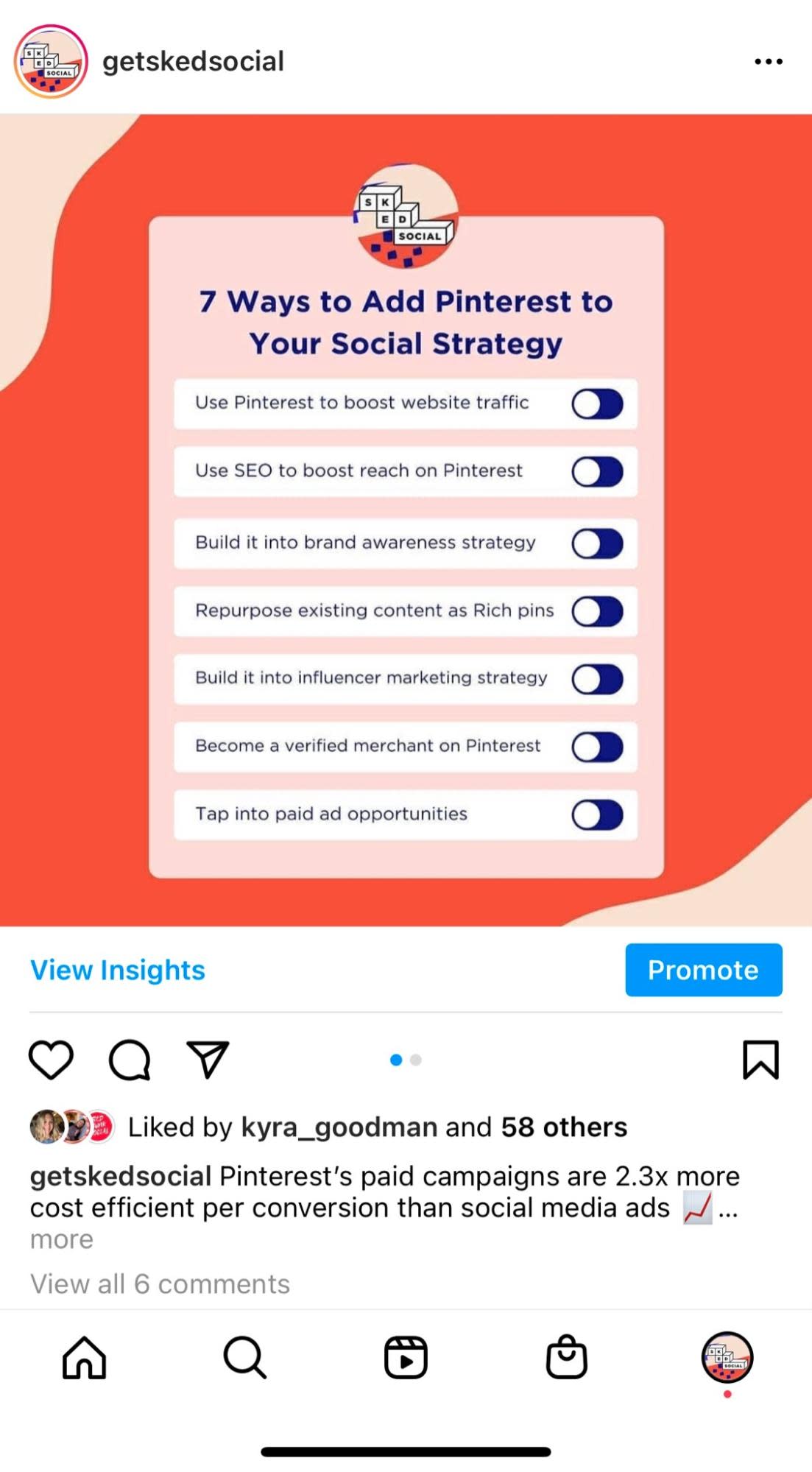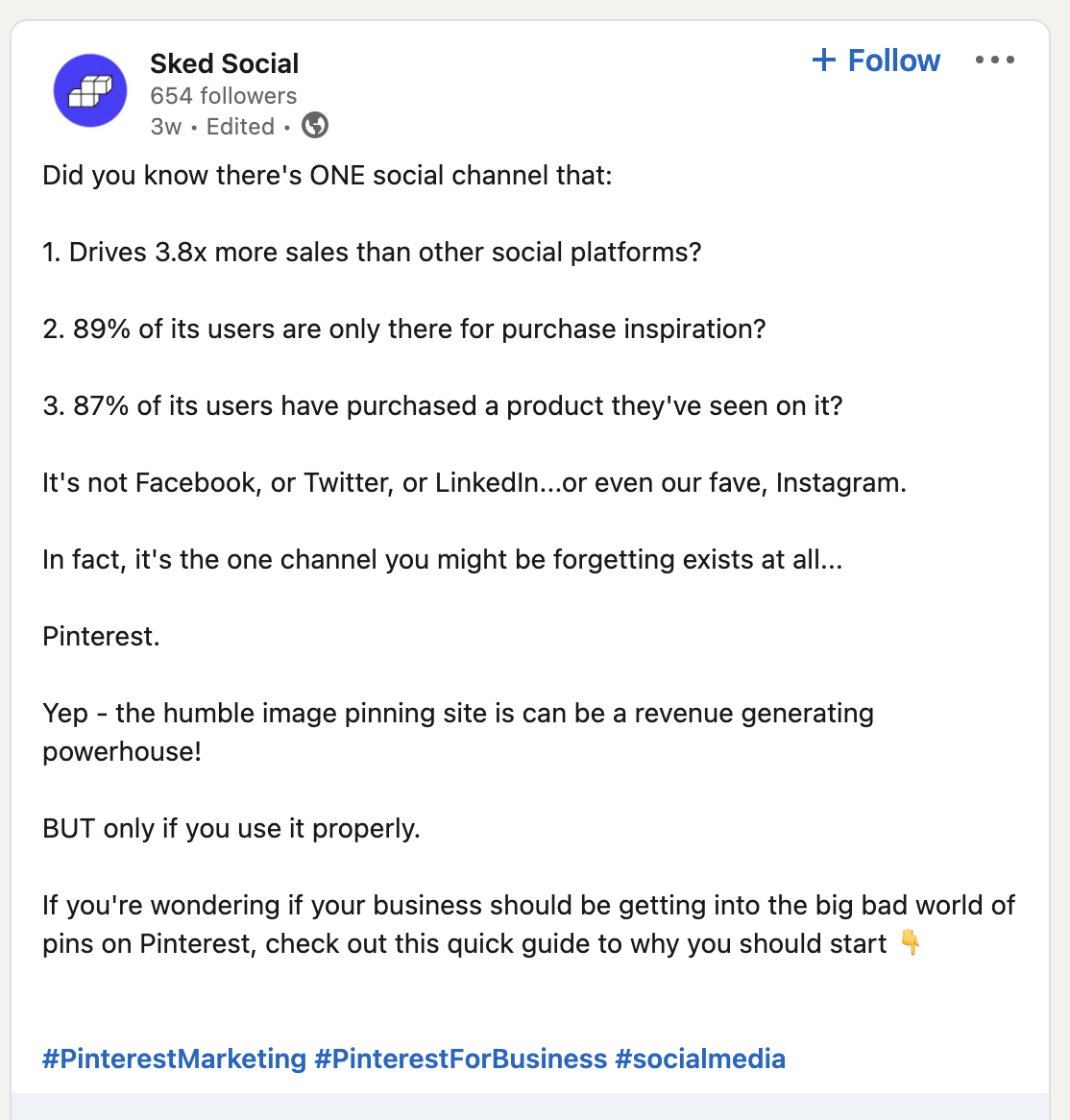Content used to be simple: you created something (a blog, a podcast, a video), and then you shared it out across every single social media channel that you could. You'd use the same captions, the same hashtags, the same copy for everything. The principle was called COPE: create once, publish everywhere.
But it's not that simple anymore. There are more channels than ever, and every single one of them has fierce competition. Plus, you can't afford to have your content grate against users' experience. In the same way we can become blind to ads or lose the thrill of novelty at some new way of interacting with the digital world, people become finely attuned to how things fit on different platforms.
Simply put: Facebook is for your friends. LinkedIn is for work. Instagram is for inspiration. TikTok is for snacking on content. And so it's not enough to COPE anymore. Now you have to CO;TD: create once, tailor distribution.
At Sked Social, we know the power of CO;TD. Not only because our most successful clients make sure each piece of content is perfectly aligned to every channel they post to, but also because we have to do it too to stay competitive in a crowded market.
Here's our method of breaking down long-form content across different social channels—and how you can copy it without breaking a sweat.
Step 1: Review your long-form content
A few years ago, it probably worked to scan the headline, intro, and conclusion to figure out what to say in posts shared across every channel. But when something is fit for everywhere, it doesn't work anywhere. Reviewing a piece of content means actively consuming it and taking notes.
As you review your content, you'll want to make note of:
Information, data, or stories that would be perfect to tell through pictures
Any quotes, one-liners, or statements that would be bold and provocative on their own
Information that seems counterintuitive
Information that's important to different segments of your customer base or their frame of mind (e.g., if your long-form topic is about B2B marketing practices but there's advice that works for both B2B and B2C)
Anything that could spark a conversation or debate (and be sure to note which channel you think it would resonate most on)
This way, instead of scanning for keywords, you'll start to see proper nuggets of gold. Take this article we wrote about Pinterest for social media agencies and freelancers:

Despite the fact it's a niche of a niche of a niche (how a specific vertical/industry can use a single platform to fulfill a desire of one market), some of the advice in there is universal. But you wouldn't be able to pick that out if you'd only glanced at the headline. That's why a thorough review is always worth it.
Step 2: Determine your asset types for each channel
Your review should have netted you bits and pieces of content—anything from a key quote from a thought leader in your industry to a hilarious outtake in a video. Now you have to decide how you present it and where it should go.
There are two things you'll need to consider:
What type of content is best suited for each channel
What your audience likes and expects from you for each channel
We reviewed our Pinterest article and found that it had great points to share across three channels.
Instagram is our best channel; it's where our most highly engaged audience lives. They're social media fanatics always on the lookout for ways to improve their social presence. So for these followers, we tweaked the angle of the content from "adding Pinterest to a client's social strategy" to "adding Pinterest to your social strategy." Like so:

LinkedIn is home to a lot of social media professionals looking to get more for their business, whether they're in-house, with an agency, or a solopreneur. It's our least popular channel currently, so our goal was to spark interest and drive the audience to our Instagram, where they could see our thriving community there.

If you're creating content about the platform, it should live on the platform! This was new to us, so we did some investigating and saw that short-form video was extremely popular. Like other great content on Pinterest, we made sure the thumbnail gave enough interest to capture attention and provoke the pinner into clicking.

Step 3: Create tailored content
Knowing what you're going to publish to which channel is the easy part: now you have to create the new content. It might feel like a lot to create new content when you just finished an awesome long-form project, but remember: the whole point is to create as much as you can with what you have before you have to create something completely new.
Continuing our Pinterest example: when it came to creating the content, we decided that we would put our energy into the Instagram content, then share that link from our other social channels, with just a bit of content creation for each.
Here's our process:
1. First, we make our Instagram graphic through Sked Social's Canva integration.


2. Then, we schedule posts across our best platforms with unique copy and content.

3. Finally, we review our social media calendar.

And that's that. All of our tailored content is delivered in the right way to the right platform.
The benefits of breaking down your long-form content
Your long-form content isn't for everyone. As excited as you are about your niche, and as engaged as your superfans are, it's a small circle to operate in.
For those on the edge of that circle, these bits and pieces give them the chance to engage with your brand on their own terms. It won't always feel like a huge success, and sometimes the numbers can be disheartening. But you'll often find that those pieces, when positioned right, and for their best-intended audience, can bring in a whole new array of followers you might have missed.
At the very least, it's worth running the experiment.
This was a guest post from Mark Ankucic, the content strategist at Sked Social. Sked Social is an Instagram-first social scheduling tool that lets you manage your Instagram, Facebook, Pinterest, LinkedIn, Twitter, Google My Business, and YouTube content effortlessly. Want to see your work on the Zapier blog? Read our guidelines, and get in touch.






